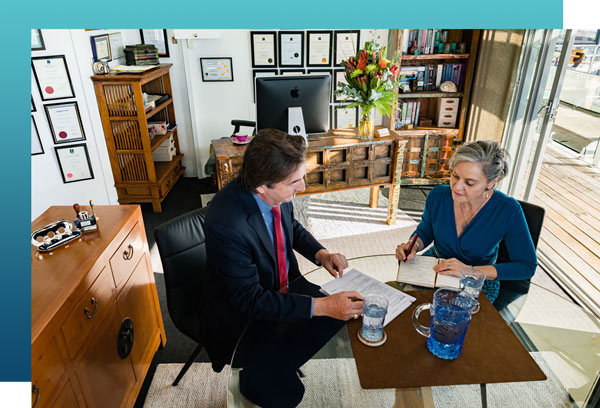Divorce can be a stressful and confusing process without guidance and support. Whether you are currently going through a divorce or you have plans to separate in the future, proper advice and insight into how to get a divorce in Australia can help make your application easier. Our How You Can Get Your Divorce In Australia Guide covers everything you need to know about applying for divorce, broken down into practical, simple sections for you to follow. Read on now for all the details necessary to complete your divorce application:
Before you apply for divorce
Before starting the divorce application process, it is crucial to understand whether you are filing as a sole applicant or whether you are making a joint application with your ex-partner. While the forms for each are the same, the process following filing is slightly different.
Sole application
When you are the only person applying for a divorce you are making a sole application. If you make the application, you will be the Applicant and your ex-partner will be the Respondent. As a sole applicant, you are the only one that needs to sign the application. You will need to serve the application on your ex-partner, the respondent, but their signature is not required for the divorce process.
If you and your former partner had children together who are under 18 years when you file your sole application, court attendance is required. If you do not have children together, or your children are older than 18 years, you do not have to attend court to finalise your divorce.
Joint application
If both you and your former partner sign the documents for your divorce application, then you are making a Joint application for divorce. In this case, either you or your former partner will complete the joint application and file it, before providing it to the other to review and sign. Simply put, Joint applications require both you and your ex-partner to sign the documents, and there is no requirement to serve the documents on one another.
Usually, you do not need to attend Court, if you or your ex-partner have signed a joint application, except if you or your ex-partner choose to attend court as a part of the divorce application form. This may be a suitable option if you and your ex-partner cannot agree on parenting arrangements regarding your children.
Want to learn more about our divorce law services?
Our experienced divorce lawyers can help you understand your options and take that next important step towards resolving your property and parenting matters. Learn more today!
Eligibility for divorce
In Australia, to divorce, you need to meet certain eligibility requirements. These include:
Australian eligibility requirements
You need to be an Australian citizen or intend to continue to live in Australia, having been resident in Australia for 12 months.
Separation period
A separation of at least 12 months and one day is required to be eligible for divorce in Australia.
Marriage certificate
You will need to provide your marriage certificate to prove that you were married either in Australia or abroad.
Are you ineligible to apply for divorce?
If you don’t meet any of these eligibility criteria, we can still help you. Check out our family law page to learn more about our separation services!
Considerations for divorce
Before you begin the divorce process, you will need to consider the following for your application:
Marriage of less than two years
If you have been married for less than two years, you will need to provide an additional counselling certificate as proof of the breakdown of the marriage.
Separated under the same roof
If you and your former partner live under the same roof, you will need to prove your separation through additional documentation and, if possible, third-party corroboration of evidence. This means that someone, ideally an independent, professional person, who knows you and who can vouch for your living circumstances, may need to provide an affidavit to verify.
Children
If you have had children with your former partner during your marriage who are not yet 18 years old, you will need to include details of arrangements including: care, housing, and schooling.
Living or married overseas
If you live overseas or you were married overseas, you will still be eligible for divorce in Australia if either you or your former partner meets the eligibility criteria.
Spouse cannot be located
If your ex-partner cannot be found, this means divorce documents cannot be served. You will need to make a further application to the court for substituted or dispensed service.
Let us help you stay out of court
We always prefer to keep our clients out of lengthy court battles so you can rebuild your lives as soon as possible. If you’d like to learn more about our mediation services, click the picture above!
How to get a divorce in Australia step by step
Step 1: Begin your separation if you are not already separated
As you will have read above, to begin the divorce application process, a separation period of at least twelve months and one day is required. If you are in the early stages of separation, you will be required to wait 12 months to prove the irretrievable breakdown of your marriage. If you get back together during separation and separate again, you will not have to restart the separation timer, if reconciliation was less than three months and if you only reconciled occurred once.
Step 2: Gather all documentation
To apply for divorce, you will need specific documentation and information. Primarily, you will need proof of marriage through your marriage certificate. If your marriage certificate is in another language, you will be required to translate it to complete the process. You will also need proof of jurisdiction, such as a passport or visa, and if your marriage lasted less than two years, you will need to provide a counselling certificate.
Step 3: Seek legal advice if necessary
If you are unsure about your application, or you have specific questions about the divorce process, now is the time to seek expert legal help. A divorce lawyer or specialist will guide you through the application and support you in filing and serving divorce documents.
Step 4: Complete your application
In Australia, the application for divorce is completed directly through the Commonwealth Courts Portal in an easy-to-follow format. This flow chart from the Federal Circuit and Family Court of Australia covers the application in detail.
Step 5: Pay applicable fees
To lodge your application, you will need to pay a fee of $940 to the Federal Circuit and Family Court of Australia. If you cannot afford this, you may be eligible for a reduced fee of $310. You will need to provide evidence if you wish to file your divorce application at the concessionary rate. If you are the sole applicant, you do not both need to be eligible. The exact requirements for a reduced fee are listed on the FCFCOA.
You will need a Mastercard or Visa card to pay your filing fee.
Step 6: eFile your application with the Commonwealth Courts
Once you have made payment, your completed divorce application is then eFiled directly with the Commonwealth Courts Portal. You will need to register your account on the portal to submit documentation and access court files as required, should your divorce go to court. If you have difficulty with the eFiling process, at Anumis Legal, we can assist you with this process, or eFile for you. We understand that technology can be challenging, especially when you are taking this final step and you may be emotional, even if you want to finalise your divorce. Ask Nadine Love to assist you by emailing her directly: nadine@anumis.com.au.
Step 7: eFile additional documents
If you are required to provide additional documents and evidence to support your application, you can also do so through the eFiling online service. Full details of how to file further documents are covered here.
Step 8: Serve the Application for Divorce to the other party
If you have applied for divorce as a sole applicant, you now have the responsibility of serving your former partner with your Application for Divorce. If you are unaware of your ex-partner’s whereabouts or they are being deliberately evasive, you will need to apply for a service order through the court. You can also talk to us at Anumis Legal about engaging a process server to serve the documents for you. Ask Nadine Love to assist you by emailing her directly: nadine@anumis.com.au.
Step 9: Attend court if required
Many applications for divorce do not require attendance in court, though this is a requirement in sole applications where there are children of the marriage under 18 years old. You may also choose to attend court in your application, or in some cases, either you or your former partner may object to the divorce or directly oppose it. All divorce hearings are now held electronically, making it easy for both you and your former partner to dial into the court session and take part.
Step 10: Finalise your divorce
Once a divorce is granted, it takes one month and one day for your divorce to be finalised. Except when the court gives a special order to reduce the finalisation time. Once complete, your divorce order will be freely available to you via the Commonwealth Courts Portal.
Step 11: Print and store your divorce order safely
Once you have received your divorce order digitally, it is a good idea to print and file the documentation safely so that you can provide your Divorce Certificate if need be in the future. Once your order is printed, you have done everything you need to do, and your divorce process is complete.
Are you in the midst of separation or planning on divorce? Our Anumis Legal Dream Team can help. Get in touch with Anumis Legal today to discuss our family law services, specialising in divorce in Australia. Ask Nadine Love to assist you by emailing her directly: nadine@anumis.com.au.

Nadine Love is a lawyer and part of “the dream team” at Anumis Legal. She completed her law degree at Southern Cross University and received the New South Wales Bar Association Prize for Evidence and Civil Litigation. In addition to her passion for family law and therapeutic jurisprudence Nadine is also a celebrated international author, personal & business coach, drama therapist and motivational mentor. Nadine’s interests encompass swimming and walking in the rainforest with golden retriever Anu, and Australian Shepherds, Lex, and Onyx. She combines her strengths of advocacy, empathy and out-of-the box problem solving to support her clients to achieve their best legal outcomes.



